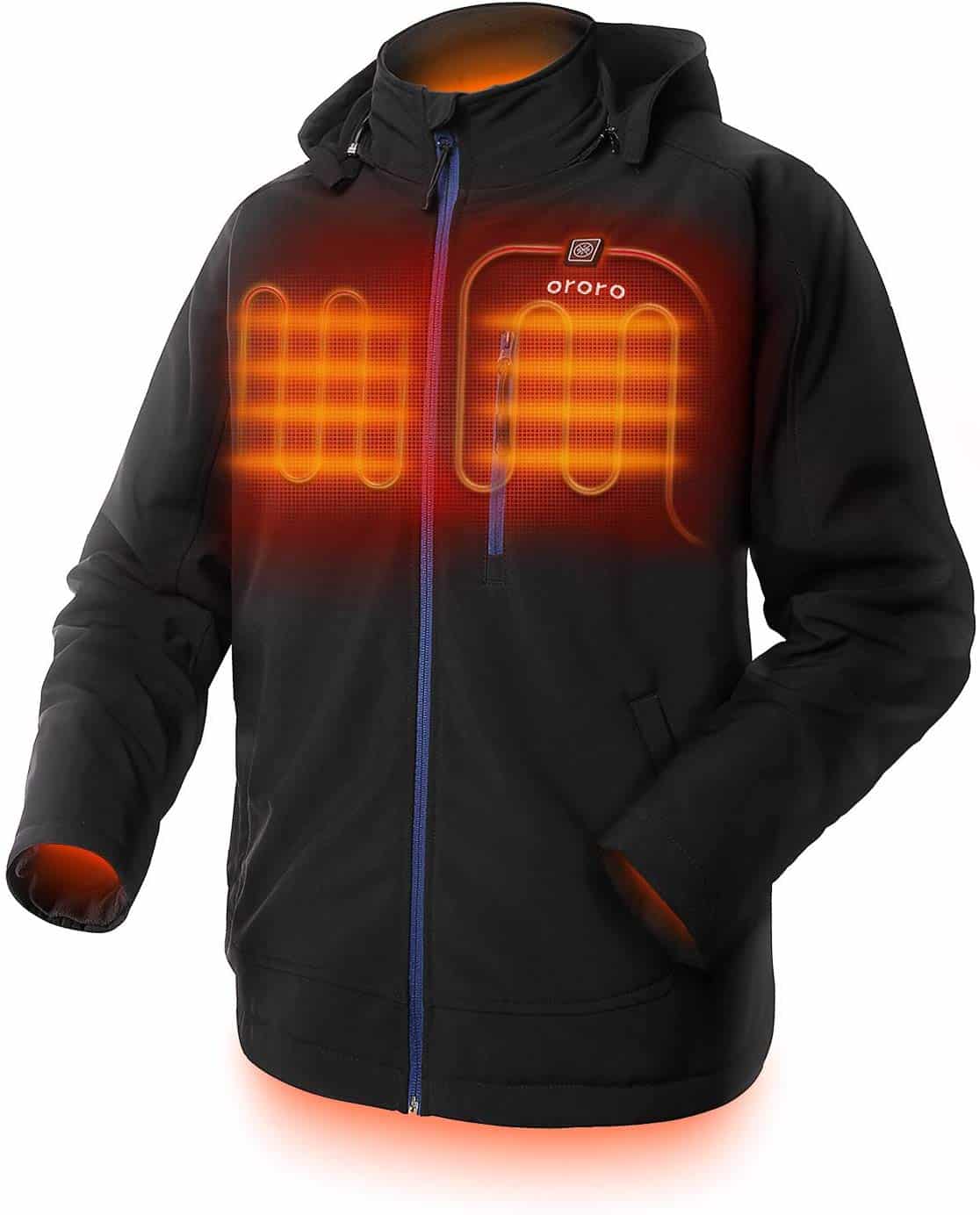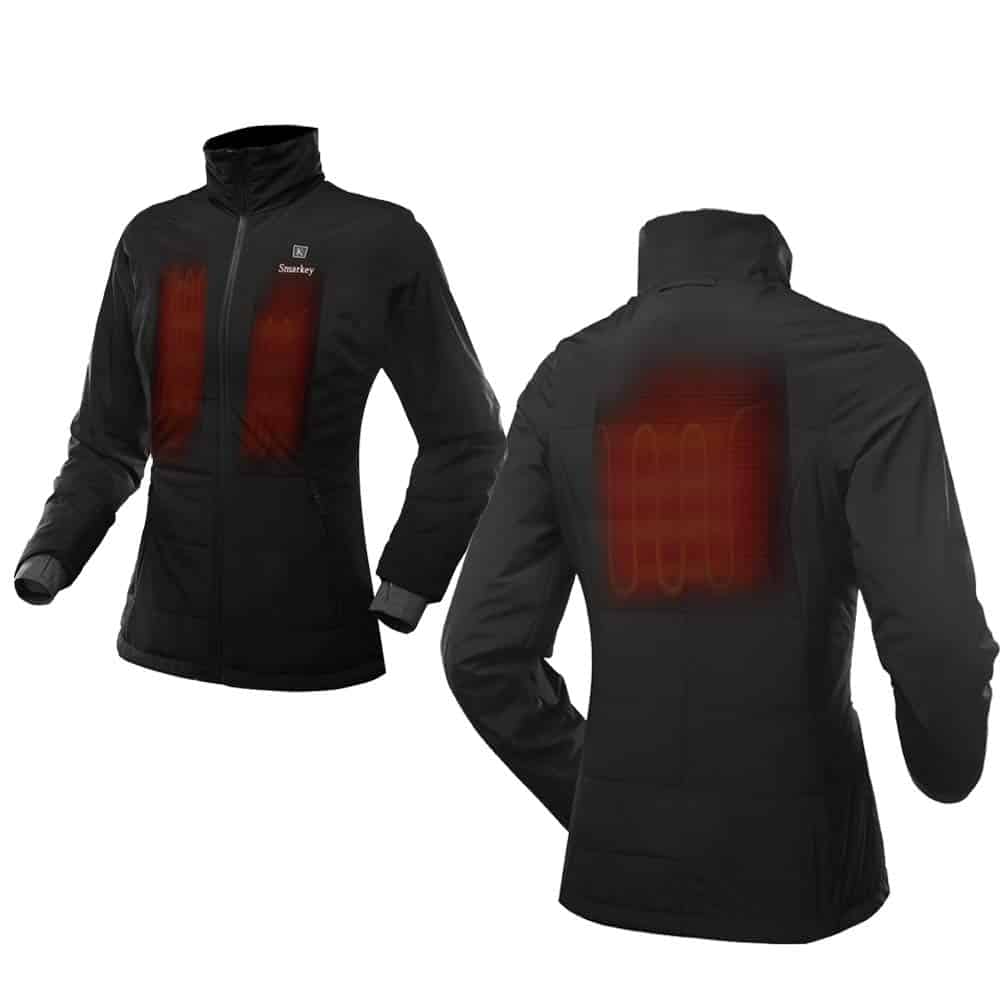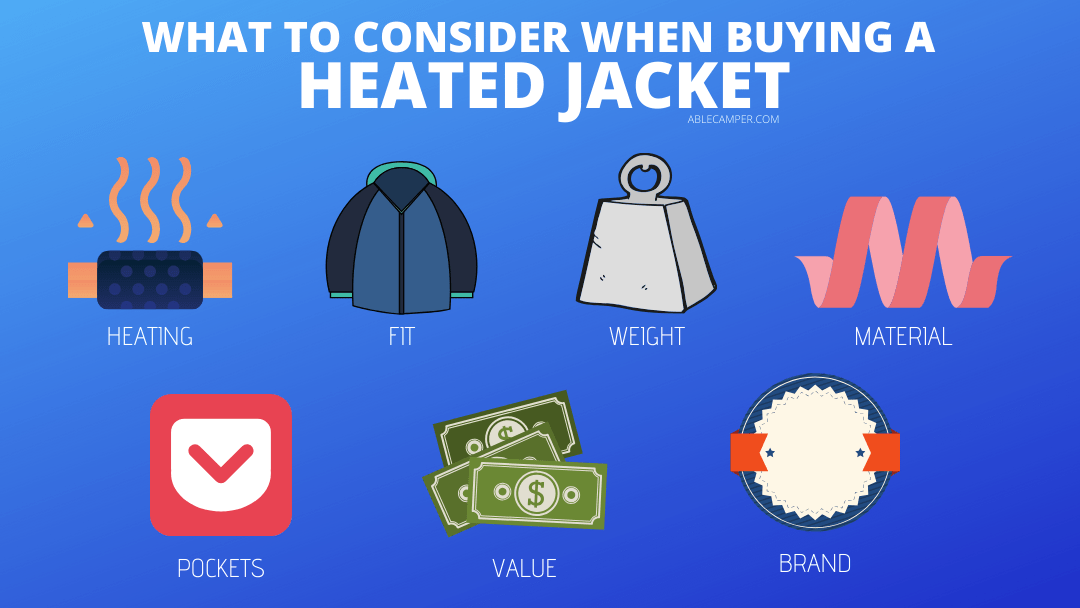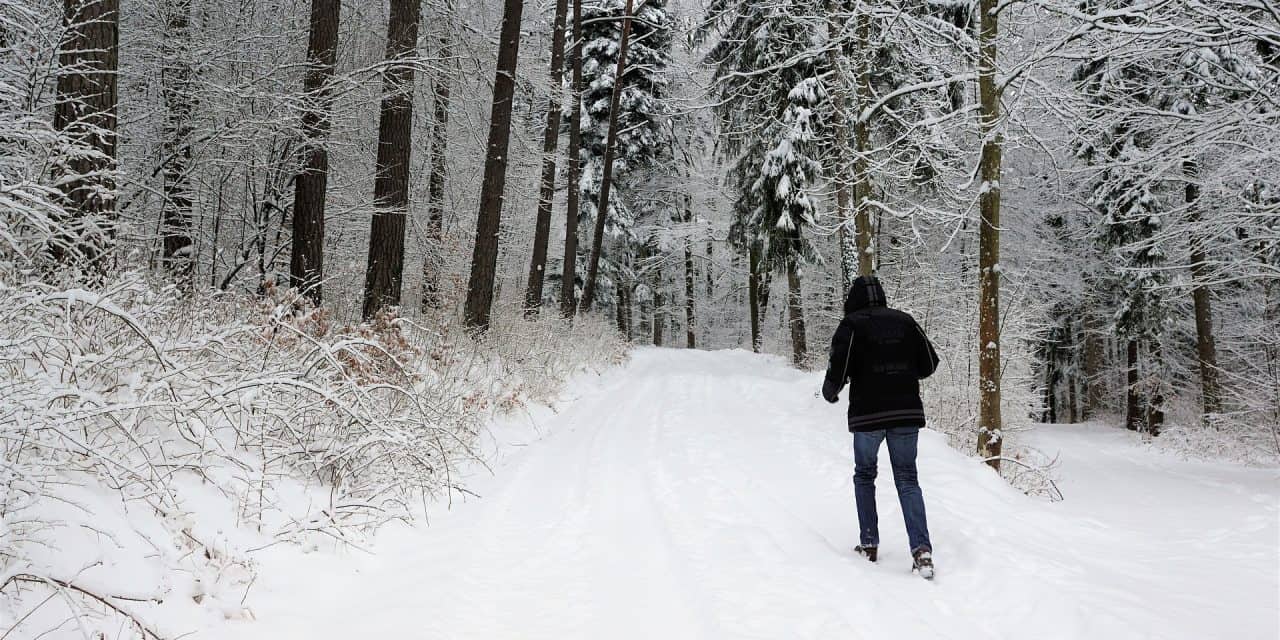Winter is cold and unforgiving. Depending on your local climate, the mere act of standing still outside can be quite painful. Sometimes you need to wear four layers of clothing just to keep from shaking, and even then, it still feels pretty cold.
Heated technology has become increasingly popular in recent years, with brands creating fashionable and effective heated jackets, vests, gloves, and even socks to battle the cold!
Despite being battery-powered, heated jackets are made to be completely safe in the rain or snow. As with all clothing, their material and composition varies in style and quality.
In the sections below, we’ll go over some important points, frequently asked questions, and our top 7 picks for the best heated jackets on the market today.
Should You Buy a Heated Jacket?
Our bodies are made to adapt to the surrounding weather. However, many of us who have faced the great outdoors in its coldest conditions know how painful the weather can be. When Mother Nature looks to inflict discomfort upon the human body, she can easily do so with biting cold winds.
If you plan on being outside for long periods of time in extreme cold, you risk falling into some serious bodily harm. Frost bite is one bad symptom that can lead to hypothermia if you’re not wearing the proper clothing.
It’s also worth noting that cold weather weakens the immune system, making it easier for harmful pathogens to infiltrate the body. This can lead to the development of a cold, flu or even pneumonia.
Heated jackets are a worthy investment for anyone who frequents the outdoors in cold weather. If you’re an avid camper, sports fanatic or you work outside all year round, then you should definitely consider buying a heated jacket.
To say the very least, this clothing innovation makes bearing cold weather a whole lot easier.
How long do heated jackets last?
It all depends on the strength of the jacket’s battery. The more power the battery is capable of holding, the more heat it will be able to disperse over a longer period of time.
The strength of the batteries tends to range from 5000mAh to 10000mAh. The run time varies greatly — you can expect anywhere between three hours to a couple days of heat depending on the model of jacket in question.
The 7 Best Heated Jackets
Heated jackets are a relatively new innovation, but manufacturers have been quick to pick up on the trend. Today, there’s a huge range for you to choose from. Each brand brings its own strengths and weaknesses to the table.
With so many options out there, it can be difficult to find your ideal fit. To help you out in the selection process, we’ve compiled the 7 top picks in the market. Keep this list close at hand as you shop around.
#1 – ORORO HEATED JACKET

Ororo is one of the leading brands in the heated jacket market. Users praise the company for their comfort, style and of course, the heat their jackets are capable of generating.
The jacket is optimally designed to provide a comfortable wear. It molds onto your body and prevents the heat from escaping.
It’s quite an attractive piece of clothing, too. Even in mild temperatures, you can put it on without the battery and look quite sharp as you run your errands.
Three different heat settings allow you great control over the temperature of the jacket. With its powerful battery, you can expect a full day of use. The battery can even be used as an option to charge your phone.
On top of all that, the high quality material is made to dry quickly in rainy or snowy weather.
pros
- Comfortable
- Stylish
- Long run time
cons
- Inconvenient zipper placement

Smarkey is another big player in the heated jacket market. Despite the heavy competition in this sphere, their product is definitely worth looking into.
This is a relatively thin coat, so it might not be the best option if you’re planning to face the harshest weather conditions. However, it’s extremely well-insulated and designed to keep the heat in.
Like Ororo, Smarkey have made a point of designing a sleek jacket. You’ll be looking good as you brave the winter climate head-on.
The battery is a little bulky, especially considering the thinness of the jacket. Its protrusion is slightly more noticeable than in other models.
However, it’s quite a reliable battery. It can last for days on its lowest setting, especially with intermittent use. This makes it a great option for campers who aren’t often in proximity of a charging point.
pros
- Lightweight
- Flexible
- Long run time
cons
- Bulky Battery

Venture Heat offer an impressive heated jacket. Users can easily toggle between the three heat settings with a wireless remote control.
There are seven heat panels strategically dispersed to provide a great sense of warmth. They don’t restrict motion, either. Through clever engineering, Venture Heat manages to balance functionality with comfort.
The jacket provides a flexible, comfortable fit, allowing you total freedom of motion. The elastic arm cuffs do a great job of keeping the heat in and the wind out.
This model is ideal for motorcyclists looking to ride in the cold. There’s a connectivity feature included specifically for use with a motorcycle battery.
Its windproof and rainproof design also makes it a good fit for bikers. Though of course, you don’t need to own a motorcycle to take this with you during a winter trek up the hill.
pros
- Additional heating elements
- Wireless remote control
- Motorcycle optimization
cons
- No color options

As an additional option, take a good look at the VENUSTAS heated jacket. Their recent design update includes a skin-friendly mylar thermal lining.
This jacket is quite light and flexible, making it a good option if you engage in demanding physical activity outdoors.
The 10000mAh battery is extremely powerful, providing up to 12 hours of heat. You can be outside all day in freezing temperatures and barely feel the cold on your body.
With an easy push of a button, you can toggle between the jacket’s three heat settings. The carbon fiber heating elements disperse heat across your abdomen and back, providing full upper-body warmth.
The hood is a nice inclusion, but you have the option of detaching it as you wish. The jacket’s USB port is great for charging your devices on the go.
pros
- Powerful battery
- Skin-friendly mylar thermal lining
- USB port included
cons
- LED button might be annoying

Milwaukee is a global brand that has built up a reputation of offering great value to customers. Their heated jacket is a great example of the type of quality they provide. You can choose your favorite color between red, grey and black options.
The high quality materials used in the making of this jacket allows for considerable longevity. The tough shell stretch polyester is as comfortable as it is durable, and the outer layer provides great resistance to the elements.
Using carbon fiber heating elements, this jacket distributes heats along the chest, back and even down to the pocket section. You can toggle between the heat settings using an LED controller.
Milwaukee engineered a Quick-Heat feature into their heated jacket. This effectively summons heat several times quicker than standard models.
One downside to this product is the battery life. A full charge will typically provide less than 5 hours of heat. If you don’t plan on having access to a power source, this might not be the best option for you.
pros
- Multiple color options
- Heats quickly
- High quality material
cons
- Low battery life
#6 – DEWALT HEATED JACKET

DeWalt is well known for their wide array of professional construction tools. They’ve supplemented their range to include a sturdy heated jacket that’s perfect for doing work outdoors.
The heating elements are excellently placed here. Aside from covering the chest and back, they also convey heat along the shoulders and arms. The overall effect is so warm, you can get quite cozy even in the face of relentless wind and snow.
Workers appreciate access to a little extra storage in their jackets. Since DeWalt knows their user base well, they’ve included five pockets in their heated jackets. On a job site, this allows for easy access to critical supplies like pencils, measuring tapes and phones.
Of course, no heated jacket is perfect, and DeWalt’s model is no exception. It has a low battery life compared to other selections in our list.
Furthermore, the battery pack is quite bulky and can become uncomfortable, especially when you’re in a seated position.
Still, depending on what your needs are, there’s a chance that this heated jackets benefits might outweigh its drawbacks. In any case, it’s definitely worth looking into.
pros
- Durable
- Great heat disbursement
- Additional pockets
cons
- Bulky battery
#7 – MAKITA HEATED JACKET

Makita is another big name in the field of construction tools. Like DeWalt, they sought to look after the needs of the exterior worker by supplying them with an exceptional heated jacket.
There’s great battery life on offer here. With a full charge, Makita’s heated jacket can supply up to 28 hours of heat. You can use it for several working shifts in a row. Or, if you’re a camper, a full charge can last the whole weekend with intermittent use.
The jacket is quite thick, so you can expect a good amount of warmth from it without needing to turn the battery on. When in use, the elements heat the body from three points located on each side of the chest and the back.
The standard color is black, but the “Mossy Oak” pattern is definitely an eye-catching alternative. With a variety of size options, you’re sure to find your ideal fit.
The downside to Makita’s heated jacket is the lack of quality and durability compared to other popular options.
Despite that, there’s a whole lot to love here. As is the case with all the heated jackets in this list, you’ll have to take a good look at their features and make your choice based on your priorities.
pros
- Long battery life
- Comfortable
- Funky “Mossy Oak” color option
cons
- Lacks durability
How Does a Heated Jacket Work?
There are two main types of heated jackets.

#1 – Electrically Heated Jackets
This is by far the most common and effective type and the only category that we’ve featured in our top 7 list. They’re the more expensive option of the two, but great value comes with their higher price point.
Electrically heated jackets work with battery-powered heating elements placed within the material. They allow you to control the amount of heat dispersed throughout the jacket.
Some users fear electrocution or fire from electrically heated jackets, but this concern can generally be dismissed since there are no live circuits used for their operation.
All things considered, electric models are well worth the extra investment.
#2 – Chemically Heated Jackets
These jackets work in the same way hand warmers do. When their thermal packs are agitated, they disperse heat throughout the body.
There’s no hardware required in their use, which is one factor that drives down their cost. However, due to the nature of how they work, users can’t control the amount of heat being generated.
In many cases, chemically heated jackets can become quite scalding and painful to wear. You’d need to pack a few layers of extra clothing to make sure you don’t burn yourself.
That’s all we’ll say about chemically heated jackets here. Despite the lower price tag, you’re definitely better off with an electric model.
What to Consider When Buying a Heated Jacket
Now that you’ve seen our top picks, you have a sense of what a good heated jacket looks like. Still, depending on your specific needs, you may have to dig a little deeper in order to pick the right one.
We’ve broken down the core elements of a heated jacket. These form the basis of our criteria in building this list. They’re all things you should consider when buying a heated jacket.

Heating
A heated jacket’s heating components are broken down into two elements: temperature control and the zones in which the heating elements are placed.
Standard placement of heating elements are along the chest and back. The heat is meant to spread from these large, core areas of the upper body to the extremities.
However, certain heated jackets use additional heating elements. These typically include zones along the collar, elbows, upper arms and pockets.
Generally speaking, more heating elements will result in a greater sense of warmth. This isn’t always the case, though. A high quality jacket that uses three well-placed elements might feel warmer than a low quality one with five misplaced elements.
Heat elements are either made in the form of carbon fiber or steel. Carbon fiber is the more flexible option of the two, and can be put in the washing machine on a gentle, cold water cycle. However, be sure to read the manufacturer’s instructions carefully before giving it a wash.
Steel is the less convenient heating element material of the two. It’s rigid, not foldable and definitely must be washed by hand.
Almost all electrically heated jackets come with the option to toggle between temperature settings. However, they don’t tend to correspond to specific temperatures. Doing so would be overly complicated since the outside temperature and wind levels are in constant flux.
A standard practice among heated jacket users is to start at a high temperature setting. Once a feeling of warmth is achieved, you can lower the settings and maintain your preferred level of comfort as you see fit.
Fit
Ensuring a good fit is an important part of shopping for any type of clothing. However, it’s even more critical when choosing a heated jacket.
Needless to say, if your jacket is too loose, the heat will escape from the openings at its extremities. Instead, it’s important to trap the heat within the jacket to increase warmth.
On the other hand, if your jacket is too tight, there might not be room to add extra layers of clothing underneath. Furthermore, depending on the construction of the jacket, the heating elements might prop up too tightly against your body, leading to uncomfortable, direct heat.
Take a good look at the product dimensions, and ensure that the heated jacket you choose will be a proper fit.
Weight
The material of most heated jackets tends to weigh quite similarly. However, the differences in weight become apparent when you factor the weight and placement of the battery packs.
Have a good look at each jacket’s specifications and take note of the battery pack’s weight. Additionally, you’ll want to look at where it’s placed within the jacket. Certain areas are more optimal than others depending on the tasks you plan on doing while wearing the jacket.
It’s also important to ensure that the battery pack does not move or swing around while in use. This point boils down to choosing a high quality jacket manufactured by a reputable brand.
Material
The material of some heated jackets are thicker and heavier than others. Whether you’re better suited to a thinner or thicker material depends on your specific needs from the jacket.
Regardless of thickness, most fabrics are made to be quite breathable. This is important, otherwise the jacket can feel quite stuffy with all the heat it’s generating.
When it comes to material, you’ll either find yourself choosing between a jacket that’s weather resistant or one that allows for more freedom of motion. It’s possible to find a good balance between the two, but don’t expect to nab one that maximizes both attributes.
Pockets
All heated jackets come with at least two pockets, and some offer several more. To certain users, the lack of additional pockets is a deal breaker. To others who use their heated jackets while carrying additional storage (such as a tool belt), extra pockets aren’t that big of a deal.
It all depends on what you plan on doing with your heated jacket. If you’re using it on job sites or to go hunting, having some extra pockets will likely add some convenience.
Value
As is the case with any article of clothing, costs of heated jackets vary depending on the quality of materials and care used in their production. In this case, though, there’s an added dimension of functionality that makes finding the right value even more important.
By choosing among the cheapest models on the market, you’re limiting yourself to a heated jacket that won’t grant you much breathability, flexibility and general comfort. The battery in cheaper jackets isn’t likely to last very long, either.
On the other hand, if you’re willing to invest a little more, you’ll likely find yourself with a heated jacket that offers you the best of all important attributes. It’s in your best interest to shop around and find the right deal to suit to your needs.
Brand
When choosing a heated jacket, it’s best to stick with known brands that have an established presence in the sphere.
While it’s true that start-ups may potentially offer great value and innovative product ideas, brands like Ororo, DeWalt and Milwaukee put their hard-earned reputation on the line with each of their products.
Big brands not only ensure the use of high quality materials in the making of the jackets, but they also tend to opt for high quality batteries. A proper battery is fundamental in ensuring the performance and longevity of a heated jacket.
Take a look at all your options — including start-ups if they put an interesting offer on the table — but keep in mind that established brands are likely the safer bet.
How to Wash a Heated Jacket

It’s very important that you follow your heated jacket’s specific washing instructions. Models with steel heating elements can’t be washed in a machine, and this might apply to certain carbon fiber models as well. With that said, here’s a general overview on putting a heated jacket in the wash.
Obviously, you can’t throw it in the machine without removing the battery pack. The first step is detaching the battery pack and stocking it away in a safe place. If there are major stains on the jacket, it’s best to try removing them by hand before putting them in the machine.
Next, use a gentle, cold water cycle to wash the jacket. Once it’s ready to dry, put it out to hang. Don’t use a drying machine and don’t wring it dry, as you’ll risk damaging the elements.
Now your jacket is fresh, clean and ready for the next round of adventures.
A Few Notes on Batteries
Since the battery forms the power source of your heated jacket, it’s important to understand how it works on a basic level.
Voltage and milliampere hour are the two values you should keep in mind here. Voltage determines the temperature that the heating elements on the jacket can potentially reach. Milliampere hour denotes the battery’s capacity.
Both values affect runtime, as does external temperature. The colder the climate, the harder the battery has to work to keep you warm.
If you’re a camper, it’s best to choose a higher capacity battery, and bring a replacement in case you need it. If you’re a worker on a construction site, you’ll likely have constant access to a power source, so run time is less of an issue.
Most heated jacket models offer their batteries in a kit that includes a charging station along with the battery pack.
Staying Safe (and Warm) With a Heated Jacket
Since this is electrically powered clothing we’re talking about, it’s natural to worry about the risk of electrocution, or even explosion. However, the vast majority of jackets use no live circuits in their operation, which greatly minimizes the risk factor. Also, your body is shielded from potential harm by the inner layer of the jacket.
That said, to avoid the worst case scenario, you’re much better off in choosing a reputable brand that produces a well-reviewed heated jacket. For purchases like these, it’s highly recommended that you take your time and conduct the proper research. If any red flags come up, move on to the next model.
Take note that, depending on the location of the jacket’s heating elements, some models don’t pair well with the use of a backpack. Depending on the weight of the backpack, it might press the heating element against your body which would make things a little too warm for comfort.
Now You’re Ready To Bring The Heat With You
With so many options available in the market, you’ll have to do a bit of digging in order to find the heated jacket that best suits your needs. After reading this guide, you should be better equipped to do so.
Each model comes with their respective pros and cons. In all cases, it’s in your best interest to find the right value at the most reasonable cost.
Remember to take note of the battery’s specs as well as the materials used for the clothing and heating elements. Most jackets are able to relay enough heat to keep your body warm, but their run time varies considerably.
In any case, be sure to wear adequate layers of clothing to minimize the amount of work needed from the battery. This is especially important for campers. If you’re an outdoor adventurer, you can further increase your warmth by stocking a reliable tent heater in your arsenal.
Once you find the perfect fit, your heated jacket will keep you warm for many winters to come.
- Tent Fabrics, the Ultimate Breakdown - November 19, 2022
- Don’t Go Camping Alone Before Reading This - November 18, 2022
- The 5 Best Camping Radios For 2021 - June 2, 2020






